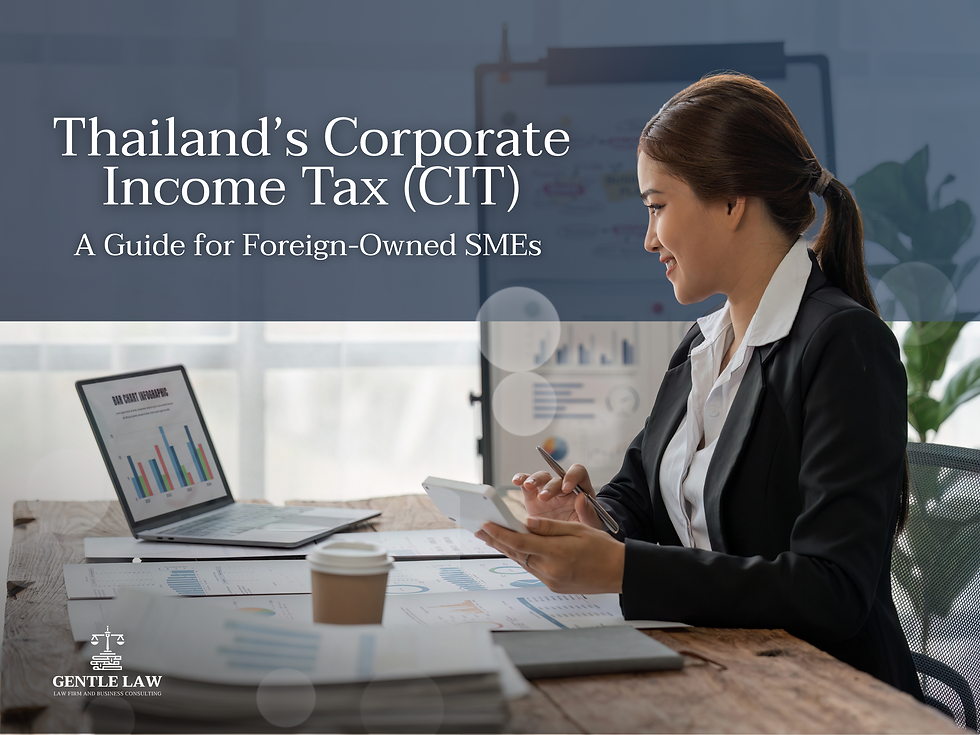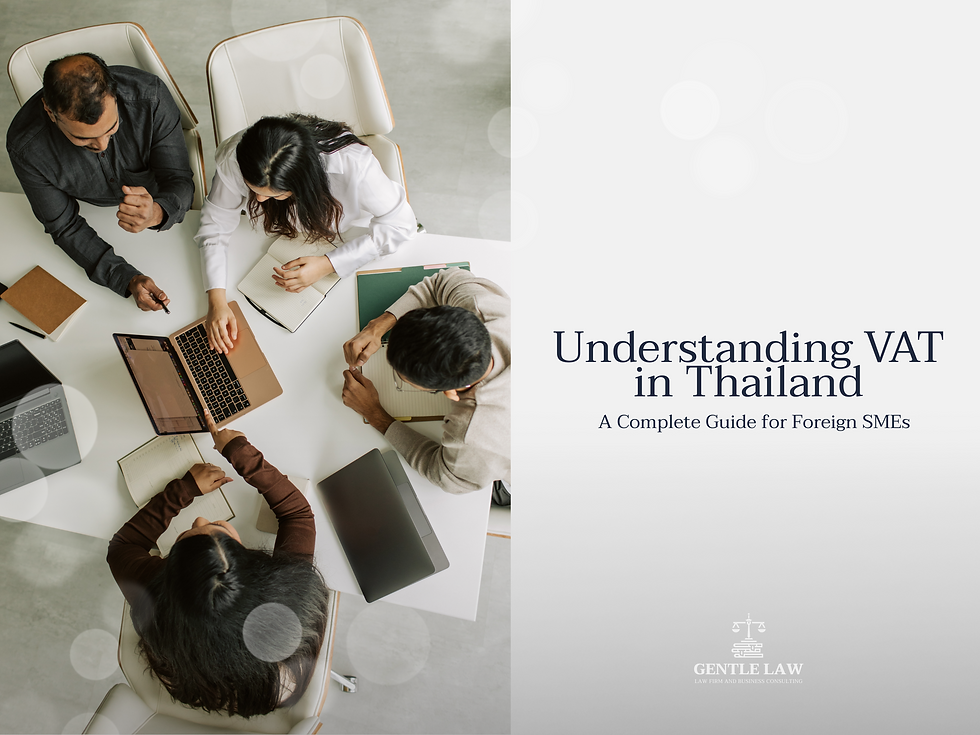Withholding Tax in Thailand: Practical Guide for Foreign-Owned SMEs [2025]
- gentlelawlawfirm
- Aug 13
- 4 min read
![Withholding Tax in Thailand: Practical Guide for Foreign-Owned SMEs [2025]](https://static.wixstatic.com/media/d1cb6c_c745eb1c966e493086313ee1a6909049~mv2.png/v1/fill/w_980,h_735,al_c,q_90,usm_0.66_1.00_0.01,enc_avif,quality_auto/d1cb6c_c745eb1c966e493086313ee1a6909049~mv2.png)
Foreign-owned SMEs in Thailand must manage withholding tax to stay compliant, protect cash flow, and pass Revenue Department audits. This guide explains what payments are subject to withholding tax in Thailand, the correct rates, monthly filing forms and deadlines, treaty reductions, and common pitfalls. Where rules depend on method or channel I flag the exact conditions and cite the legal basis.
What is withholding tax in Thailand
Under the Thai Revenue Code, payers must deduct tax at source when they pay certain types of income, then remit that tax to the Revenue Department using the correct monthly return. Typical payments include salaries, service fees, rent, royalties, interest, and dividends. Which forms do SMEs actually file each month
PND 1 payroll withholding on salaries and benefits paid to employees.
PND 3 withholding on payments to individuals or unincorporated bodies for services and certain other income.
PND 53 withholding on payments to Thai juristic persons for services, rent, royalties, interest, dividends and other specified income.
PND 54 withholding on payments to foreign juristic persons not carrying on business in Thailand under Section 70 of the Revenue Code. This is a monthly return, not an annual summary.
Monthly due date: 7th of the following month for paper filing. If you e-file, the due date is extended to the 15th. Current policy extends the e-filing grace period through 31 January 2027. Interest for late remittance is generally 1.5 percent per month.
Withholding tax in Thailand rates and examples
Domestic payments to Thai recipients (standard rates)
Payment type | Typical WHT rate |
Services and professional fees | 3% |
Advertising | 2% |
Rent of land or buildings | 5% |
Royalties | 3% |
Interest | 1% |
Dividends | 10% |
Prizes and certain others | 1% |
Rates above are standard domestic rates under current practice.
Temporary e-WHT reductions until 31 December 2025: if you remit tax via the e-withholding tax system, certain domestic rates are temporarily reduced for that filing period, for example many 3 percent items are reduced to 1 percent and some 5 percent items are reduced to 3 percent. Always confirm the category and whether the payer is eligible before applying a reduced rate.
Payments to non-residents
Dividends: 10% unless reduced by a tax treaty
Interest: 15% unless reduced by a tax treaty
Royalties: 15% unless reduced by a tax treaty
Service fees: if services are performed in Thailand, WHT can apply under Section 70 and treaty rules may modify the outcome. Use PND 54.
To apply treaty relief you must check the applicable double tax agreement and documentary requirements. The Revenue Department maintains an English portal for DTAs, and the United States treaty materials are also publicly available.
Payroll withholding
Salaries are withheld according to the progressive personal income tax table and remitted with PND 1. The employer must issue a monthly withholding tax certificate to each employee and maintain payroll records for audit.
Filing workflow and deadlines you can trust
Classify the payment and recipient correctly.
Calculate WHT using the standard rate or the temporary e-WHT rate if remitting through the e-withholding system.
Remit and file the correct return by the due date: paper by the 7th, e-filing by the 15th. The e-filing extension runs through 31 January 2027.
Issue a withholding tax certificate to the payee after each remittance. The certificate format is “50 bis”.
Keep records for at least five years after filing. For VAT-related support and in special cases the Director-General may prescribe up to seven years.
Common pitfalls and how to avoid them
Pitfall | What goes wrong | How GENTLE LAW IBL designs the fix |
Using PND 3 instead of PND 53 | Form mismatch for juristic payees causes rejection | Build a chart of accounts that maps vendors to the correct return |
Assuming e-WHT reduced rate always applies | Reductions apply only if tax is remitted via the e-withholding system | Lock the reduced rate to e-WHT workflow only and default to standard rates otherwise |
Misclassifying rent vs. services | 5% vs. 3% difference creates under-withholding | Add contract language that clearly separates rent from services with separate invoicing |
Forgetting the treaty | Over-withholding on cross-border royalties or interest | Add a treaty checklist and documentation capture before first payment |
Late filing | Interest 1.5% per month plus penalties | Calendar automation with e-filing set to the 15th extension and delegated approvals |
Treating PND 54 as an annual summary | Missed monthly filings for foreign payees | Hard-code monthly PND 54 run in the close checklist |
Sources for the above practice points and rates are linked throughout this guide.
Readiness checklist for SMEs
Payments mapped to correct forms: PND 1, 3, 53, 54
Vendor master file includes residency status and tax ID
e-WHT enabled where beneficial before 31 December 2025
Treaty relief procedure in place with documentation
Certificates 50 bis generated and delivered monthly
Records retention policy set to 5 years minimum
How GENTLE LAW IBL can help
We set up end-to-end withholding tax in Thailand for foreign-owned SMEs: classification, contract language, e-WHT onboarding, monthly filings, treaty relief, and audit-ready documentation. Our team aligns legal, tax, and operational workflows so your business stays compliant and cash-efficient.
Book a WHT compliance review at gentlelawibl.com.




Comments